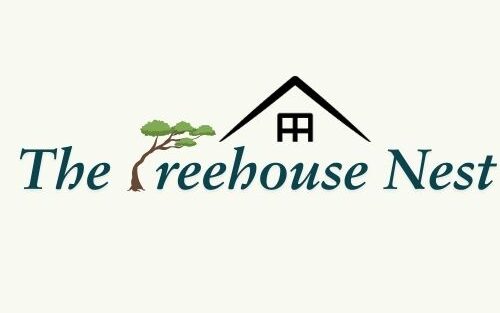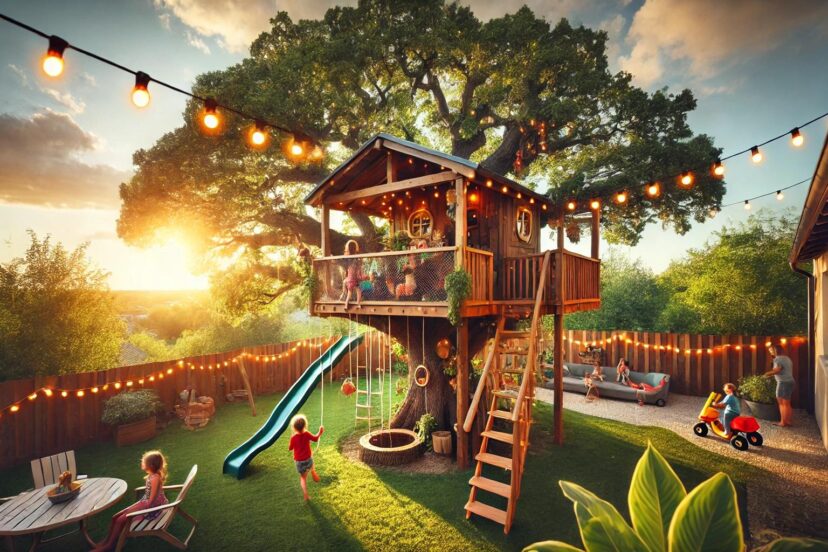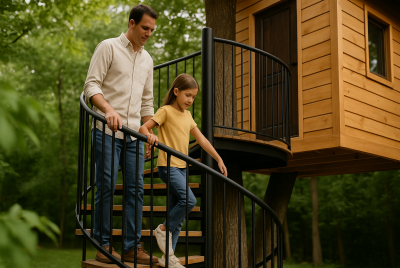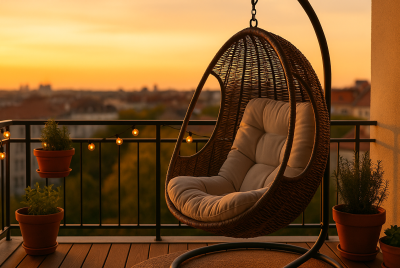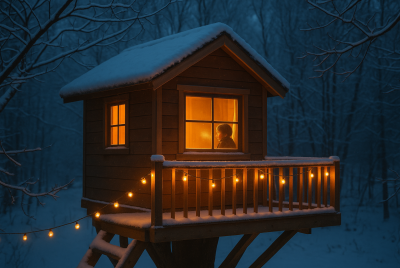Tree House for Kids: A World of Imagination and Adventure
We may earn a commission for purchases made using our links. Please see our disclosure to learn more.
It takes more than just assembling a wooden structure to build a tree house for kids. They can let their imaginations run wild there, and it’s like opening a door to their own little planet. A tree home is an enchanted haven, whether they are posing as royalty in a hidden palace or pirates protecting their ship. Let’s talk about how to build the best tree house possible and give your children a place they will always treasure.
Why Build a Tree House?
Giving your children a space to play, imagine, and simply be themselves is the goal of building a tree home. The experiences kids will have within it are more important than the building itself. Imagine the reverberation of their laughter as they ascend and gaze out into the world. A tree home is a doorway to countless opportunities; it’s more than just wood and nails.
Benefits of a Tree House for Kids
Not only are tree houses entertaining, but they also contain valuable life lessons. When they share it with friends or siblings, they teach children self-reliance, problem-solving skills, and even teamwork. They also promote outside play, which is beneficial in today’s world of screens. It’s similar to offering them a tiny bit of adventure encased in freedom.
Choosing the Right Tree
Think of the tree as the backbone of the whole operation. It needs to be healthy, strong, and big enough to hold the structure safely. Oak, maple, and fir are great choices because they can handle the load without a fuss. Choosing the right tree means the difference between a sturdy hideout and a wobbly disaster.
Safety First!
Before you get too excited, remember: safety comes first. A secure tree house is a happy tree house. Use strong materials, add railings, and consider a soft landing zone underneath—like mulch or sand—just in case. Nobody wants their kids’ magical adventure to end with a scraped knee or worse.
Simple or Extravagant?
Not all tree houses need to look like they belong in a Pinterest gallery. Sometimes, a simple platform with a ladder is all kids need to spark their creativity. But if you’re feeling ambitious, go all out with slides, bridges, or even a second story. Just remember, it’s not about how fancy it looks; it’s about the joy it brings.
Essential Tools and Materials
Building a tree house doesn’t require a fancy tool kit, but a few basics are non-negotiable. You’ll need a hammer, nails, a saw, and a drill to get started. Pressure-treated wood is your best bet since it’s tough and weather-resistant. Don’t forget a good tape measure—precision is key when you’re creating a space that’s safe and secure.
Involve the Kids
Building a tree house is the perfect chance to bond with your kids. Let them join in by painting, designing, or even holding a hammer (under supervision, of course). When kids have a say in how their tree house looks, it becomes more than a play space—it becomes their creation. Plus, they’ll be talking about “that time we built a tree house” for years.
Designing for Fun
A tree house should be as unique as your kids. Think about adding a slide for quick getaways or a rope ladder for a bit of a challenge. A trapdoor could be a fun secret feature, and a pulley system for snacks? That’s just genius. Make it a space where their imaginations can take off.
The Importance of Shade
A tree house that’s shaded by branches is like a natural air conditioner. It keeps the space cool and comfy, even on those scorching summer days. Plus, the dappled sunlight filtering through the leaves adds a magical touch. It’s like nature’s way of saying, “You’re welcome.”
Decorating the Tree House
Here’s where the fun really begins! Let the kids decorate their tree house with their favorite colors, cozy cushions, and even twinkling fairy lights. A small bookshelf can hold their favorite stories, and a few toys make it a perfect hangout. The goal is to make it feel like their very own little world.
Weatherproofing Tips
A tree house that can handle all four seasons is a tree house that lasts. Use waterproof paint or sealants to protect it from rain, and choose sturdy roofing materials to keep it dry. Regular maintenance, like tightening screws and checking for wear, keeps it safe and sound no matter the weather.
Encouraging Outdoor Play
Tree houses have this magical ability to lure kids outdoors. Pair it with a swing set or a sandbox nearby, and you’ve got the ultimate backyard play zone. You’ll find them spending hours exploring, climbing, and creating memories that no screen could ever provide. It’s a win for parents and kids alike.
Cost Considerations
A tree house doesn’t have to break the bank. You can keep it budget-friendly by using reclaimed wood or leftover materials. What matters most is the effort and love you put into it. Your kids won’t care if it’s fancy or simple—they’ll love it because it’s theirs.
Inspiring Creativity
A tree house is more than just a play space; it’s a canvas for creativity. It’s where kids can write stories, draw pictures, or pretend they’re explorers in a faraway land. By giving them a space that’s all theirs, you’re encouraging their imaginations to soar.
Keeping It Age-Appropriate
Younger kids need a tree house that’s easy to access and super safe. Older kids might appreciate a bit more of a challenge, like a climbing wall or a rope bridge. Tailoring the design to their age ensures it’s a space they’ll love—and use—for years.
Building Memories That Last
When you build a tree house, you’re not just creating a physical space—you’re creating memories. It’s the laughter, the secret hideouts, and the time spent together that truly matter. Long after your kids outgrow their tree house, they’ll carry those moments with them.
Making It Eco-Friendly
Want to teach your kids about sustainability? Building an eco-friendly tree house is a great start. Use reclaimed wood, avoid harmful chemicals, and maybe even add a birdhouse or two. It’s a small way to show them how to care for the planet while creating their dream hideaway.
Maintenance Matters
Tree houses might be sturdy, but they still need a little TLC. Check for loose boards, rotting wood, and overgrown branches regularly. A well-maintained tree house isn’t just safer—it lasts longer, giving your kids more time to enjoy it.
Adding Learning Opportunities
Tree houses can be more than play zones—they can be learning hubs too. Add a telescope for stargazing, books about nature, or a chalkboard for drawing. It’s a subtle way to mix fun with a little education, and they won’t even realize they’re learning.
Tree House Rules for Kids
Every tree house needs a few ground rules to keep things safe and fun. Teach your kids to avoid roughhousing, take turns, and clean up after themselves. A little guidance goes a long way in ensuring everyone enjoys the space.
Dream Big, Start Small
If you’re new to building, start with something simple. A basic platform with a ladder is a great beginning, and you can always add more features later. Remember, it’s not about perfection—it’s about creating a space where your kids can let their imaginations run wild.
Enhancing Your Child’s Tree House Experience with Amazon Products
Elevate your child’s tree house adventures by incorporating engaging accessories and play equipment. Here are some top-rated products available on Amazon that can add fun and functionality to their outdoor haven:
- Dolibest Safety Playground Handles
Enhance safety with these sturdy hand grips, assisting children in climbing and providing extra support. - Jungle Gym Kingdom Pirate Telescope
Encourage imaginative play with this non-magnifying telescope, perfect for young adventurers to survey their surroundings. - Swing-N-Slide Climbing Cargo Net
Add an exciting climbing element with this durable cargo net, promoting physical activity and coordination. - Treehouse Bucket Kit
This kit includes a bucket and pulley system, allowing kids to hoist items up to their tree house, enhancing interactive play. - Slackers Ninjaline Intro Kit
Introduce a ninja warrior course with this kit, featuring various obstacles to enhance agility and strength.
Scientific Research Supporting the Benefits of Tree Houses for Kids
Scientific studies and reviews highlight the many benefits tree houses and similar outdoor play structures offer for children’s growth and development. Below are key findings from well-known research that support the positive impacts of tree houses:
- Enhanced Social and Problem-Solving Skills
A study by the Forestry Commission Scotland found that children engaged in forest school activities, which often involve treehouses, showed significant improvement in social interactions, confidence, and problem-solving abilities. Learn more about these insights in this comprehensive review on forest schools. - Cognitive and Emotional Benefits of Natural Play Environments
The Journal of Environmental Psychology published a review emphasizing that unstructured play in natural settings, such as treehouses, enhances cognitive development, emotional well-being, and attention restoration in children. For more on this, explore the positive effects of urban green spaces on children.
These studies reinforce how treehouses can play a vital role in fostering a child’s creativity, resilience, and holistic development.
Conclusion: A Gift of Adventure and Imagination
Building a tree house is about more than wood and nails; it’s about creating a magical space where your kids can dream, laugh, and grow. Whether it’s a simple hideout or an elaborate tree-top mansion, the time and love you put into it will shine through. And the memories? Those will last a lifetime.
FAQs About Tree Houses for Kids
How old should my child be for a tree house?
Tree houses are great for kids aged 5 and up. Just make sure the design matches their age and abilities for maximum safety and fun.
How long does it take to build a tree house?
It depends on the design. A basic tree house can be built over a weekend, while a more complex one might take a few weeks.
Can I build a tree house without damaging the tree?
Absolutely! Use support beams and avoid nailing directly into the trunk to keep the tree healthy and strong.
How high should a tree house be?
For safety, keep the tree house between 6 and 10 feet off the ground. Younger kids might need it even lower for easy access.
What’s the average cost of building a tree house?
Costs can vary widely. A basic tree house might cost a few hundred dollars, while an elaborate one could run into thousands. It’s all about what you’re aiming for.
